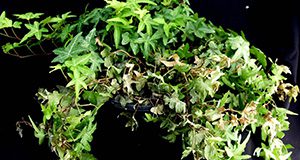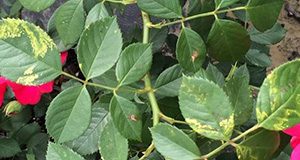English ivy has grown in popularity over the last few years as both an indoor and outdoor ornamental vining plant. While English ivy is very disease resistant, there are a few major diseases that will cause economic loss in production and landscape plantings. This 6-page document will assist residential or commercial property owners in identifying various English ivy diseases. Written by David J. Norman and G. Shad Ali and published by the UF/IFAS Plant Pathology Department, August 2018.
http://edis.ifas.ufl.edu/pp339
Tag: Nursery and Ornamental Plant Diseases
Rose Mosaic Virus: A Disease Caused by a Virus Complex and Symptoms on Roses and Management Practices
Rose mosaic virus disease is one of the most economically important diseases affecting roses, because a single symptomatic leaf can result in the rejection of complete shipments for wholesale or retail rose producers. It continues to be a problem in nursery production and landscapes. This 5-page document discusses the causes, symptoms, and management of this disease. Written by Susannah da Silva, Binoy Babu, Mathews L. Paret, Gary Knox, Fanny Iriarte, Barron Riddle, Matt Orwat, Shawn T. Steed, E. Vanessa Campoverde, and Svetlana Y. Folimonova and published by the UF/IFAS Plant Pathology Department, August 2018.
http://edis.ifas.ufl.edu/pp338
Professional Disease Management Guide for Ornamental Plants (PP202/PP123)
 Florida’s warm, humid environment is a gardener’s paradise and a great location for ornamental plant producers to grow numerous plant species — but these conditions also are suitable for the development of a wide variety of plant pathogens and insects that can spread them. Florida is also a major port of entry for the international trade of ornamental plants, which carries the risk of introducing exotic invasive pathogens, so growers are required to follow certain phytosanitory regulations. These challenges require growers to develop the most efficient production plans possible, incorporating as many tactics as they can to maximize plant health and minimize opportunities for pest and disease outbreaks—a concept known as integrated pest management (IPM). This 16-page fact sheet is intended to be used by growers, landscape professionals, and other pest control operators as a reference for managing ornamental plant diseases. Written by P. F. Harmon and S. D. Bledsoe, and published by the UF Department of Plant Pathology, June 2012.
Florida’s warm, humid environment is a gardener’s paradise and a great location for ornamental plant producers to grow numerous plant species — but these conditions also are suitable for the development of a wide variety of plant pathogens and insects that can spread them. Florida is also a major port of entry for the international trade of ornamental plants, which carries the risk of introducing exotic invasive pathogens, so growers are required to follow certain phytosanitory regulations. These challenges require growers to develop the most efficient production plans possible, incorporating as many tactics as they can to maximize plant health and minimize opportunities for pest and disease outbreaks—a concept known as integrated pest management (IPM). This 16-page fact sheet is intended to be used by growers, landscape professionals, and other pest control operators as a reference for managing ornamental plant diseases. Written by P. F. Harmon and S. D. Bledsoe, and published by the UF Department of Plant Pathology, June 2012.
http://edis.ifas.ufl.edu/pp123
ENH1121/EP380 Disinfection of Horticultural Tools
ENH-1121, a 2-page fact sheet by Geoffrey C. Dennny and Gary E. Vallad, provides assistance to producers and home gardeners in selecting the appropriate method to sterilize or disinfect horticultural tools and implements and prevent the spread of disease-causing pathogens. Published by the UF Department of Environmental Horticulture, August 2009.
http://edis.ifas.ufl.edu/EP380
PP256/PP172 Rusts on Ornamentals in Florida
PP-256, a 6-page illustrated fact sheet by Philip F. Harmon, Carrie L. Harmon, Aaron J. Palmateer, Stephen H. Brown, presents information on four representative rust diseases of ornamentals, including gladiolus rust, daylily rust, frangipani rust, and guava rust. Includes references. Published by the UF Department of Plant Pathology, May 2009.
http://edis.ifas.ufl.edu/PP172
PP257/PP257 Powdery Mildew of Gerbera Daisy
PP-257, a 4-page illustrated fact sheet by Catalina Moyer and Natalia A. Peres, describes this important fungal disease of gerberas in Florida, its symptoms, development, and management practices. Includes a table of fungicides registered to control powdery mildew on ornamentals in Florida. Published by the UF Department of Plant Pathology, July 2008.
http://edis.ifas.ufl.edu/PP257

